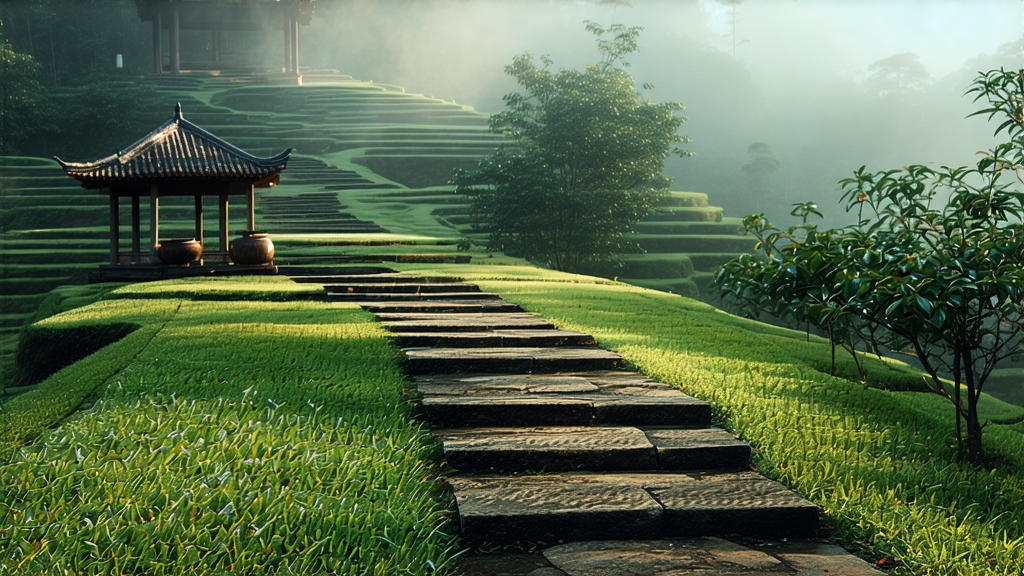
Among the six major chromatic families of Chinese tea, yellow tea is the rarest, often called the “imperial ghost” because its production was once confined to palace tribute lists and its craft was guarded by hereditary monks. Within this elusive clan, Meng Ding Huang Ya (蒙顶黄芽) stands as the most venerated, born on the summit of Meng Ding Mountain, the first recorded tea garden in written Chinese history (53 BCE). For two millennia the 1,450-metre massif has inhaled the Min River’s monsoon vapour, exhaling a perpetual cloud cloak that filters sunlight into a cool, jade-green glow—ideal for coaxing the slow, tender growth needed for yellow tea’s signature “sealed yellowing” step.
History: From Han Court Tribute to Republican Refuge
Meng Ding’s connection to throne and temple began when the Daoist monk Wu Lizhen planted seven tea bushes on the summit, presenting their spring buds to Emperor Wu of Han. By the Tang dynasty the tea was measured in “gold foil packets,” each containing exactly 365 buds, one for every day of the imperial year. When the Ming court abolished compressed tribute cakes in 1391, the mountain’s monks reinvented the leaf as a loose yellow tea, adding the micro-fermentation step that tames grassiness without reaching the oxidation level of oolong. During the 1930s war-time retreat to Sichuan, scholars of the Academia Sinica documented the process in field diaries, inadvertently saving the craft when mainland factories later pivoted to green-tea volume.
Micro-Terroir: Cloud Forest in a Cup
The garden zone sits just above the perennial cloud base but below the frost line; humidity hovers at 88 % while diurnal temperature swing can exceed 12 °C within a single spring day. The soil is a friable purple sandstone rich in selenium and zinc, elements that translate into a subtle umami undercurrent. Only the spring “ming qian” buds—standard one-bud-with-one-initial-leaf, 18–22 mm length—are plucked between 5 a.m. and 9 a.m. while the leaf turgor is still taut with overnight dew.
Craft: The Secret 48-Hour “Men Huang”
Although often glossed as “yellowing,” the process is closer to controlled suffocation. After a 70-second 160 °C pan-kill-green that locks in 8 % residual enzyme activity, the buds are piled 3 cm deep in bamboo trays slipped into a pine-wood cabinet lined with wet hemp cloth. Every 90 minutes the tea master inserts a forearm to feel for the exact moment when the stack’s core reaches 38 °C and emits a faint loquat aroma; the pile is then fluffed and restacked, repeating the cycle for two full days. This low-oxygen, high-moisture micro-environment oxidizes flavonols into golden-yellow theaflavins while preserving catechins, creating the honeyed, nut-sweet cup that distinguishes yellow from green tea. Finally the leaf undergoes a slow 55 °C charcoal bake over three nights, each night’s embers slightly cooler than the last, reducing moisture to 5 % and adding a whisper of praline.
Grades & Nomenclature
- Imperial Tip (黄芽皇): 100 % single buds, down so thick it looks frost-tipped; production <20 kg per year.
- Summit Fragrance (顶山香): one bud to first leaf, the grade most exported; balanced liquor.
- Mist Ring (云雾圈): slightly larger two-leaf pluck, yellowing shortened to 36 h; more vegetal but still honeyed.
Brewing: The “Triple 85” Rule
Water: spring water at 85 °C. Ratio: 1 g leaf to 85 ml water. Time: first infusion 85 seconds. Vessel: tall, thin-walled 150 ml Jingdezhen porcelain gaiwan to accentuate vertical leaf dance. After the initial rinse (5-second flash to awaken the down), tilt the gaiwan lid at 15° to create a 2 mm vent that prevents over-stewing. The second steep descends to 75 °C for 60 seconds, the third rises back to 90 °